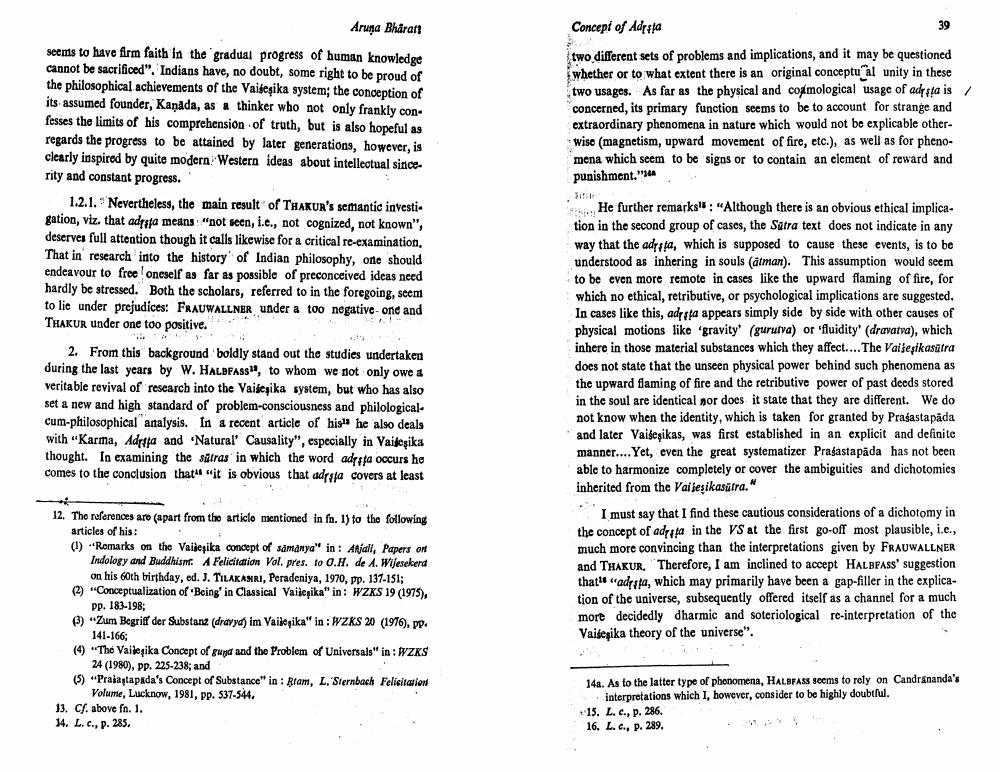Book Title: Note On Concept Adrsta As Used In Vaisesika Sutra Author(s): A Wezler Publisher: A Wezler View full book textPage 3
________________ Aruna Bharat Concepi of Adesta two different sets of problems and implications, and it may be questioned whether or to what extent there is an original conceptual unity in these two usages. As far as the physical and cozmological usage of adrefais / concerned, its primary function seems to be to account for strange and extraordinary phenomena in nature which would not be explicable otherwise (magnetism, upward movement of fire, etc.), as well as for phenomena which seem to be signs or to contain an element of reward and punishment." Ji! seems to have firm faith in the gradual progress of human knowledge cannot be sacrificed". Indians have, no doubt, some right to be proud of the philosophical achievements of the Vaidepika system; the conception of its assumed founder, Kanada, as a thinker who not only frankly con fesses the limits of his comprehension of truth, but is also hopeful as regards the progress to be attained by later generations, however, is clearly inspired by quite modern Western ideas about intellectual since. rity and constant progress. 1.2.1. Nevertheless, the main result of THAKUR's semantic investigation, viz. that adrsta means "not seen, 1.c., not cognized, not known", deserves full attention though it calls likewise for a critical re-examination, That in research into the history of Indian philosophy, one should endeavour to free oneself as far as possible of preconceived idcas need hardly be stressed. Both the scholars, referred to in the foregoing, scem to lie under prejudices: FRAUWALLNER under a too negative one and THAKUR under one too positive. 2. From this background boldly stand out the studies undertaken during the last years by W. HALDFASS", to whom we not only owes veritable revival of research into the Vaisenika system, but who has also set a new and high standard of problem-consciousness and philological cum-philosophical analysis. In a recent article of bish he also deals with "Karma, Adrsta and Natural' Causality", especially in Vaifeşika thought. In examining the sätras in which the word adref occurs he comes to the conclusion that it is obvious that area covers at least He further remarks" : "Although there is an obvious ethical implication in the second group of cases, the Satra text does not indicate in any way that the adesta, which is supposed to cause these events, is to be understood as inhering in souls (atman). This assumption would seem to be even more remote in cases like the upward flaming of fire, for which no ethical, retributive, or psychological implications are suggested. In cases like this, adesta appears simply side by side with other causes of physical motions like 'gravity' (gurutva) or 'fluidity' (dravatva), which inhere in those material substances which they affect. ... The Vaijesikasutra does not state that the unseen physical power behind such phenomena as the upward flaming of fire and the retributive power of past deeds stored in the soul are identical nor does it state that they are different. We do not know when the identity, which is taken for granted by Pragasta pada and later Vaiseşikas, was first established in an explicit and definite manner.... Yet, even the great systematizer Prasastapada has not been able to harmonize completely or cover the ambiguities and dichotomics inherited from the Vaijesikasutra." I must say that I find these cautious considerations of a dichotomy in the concept of adyata in the VS at the first go-off most plausible, i.e., much more convincing than the interpretations given by FRAUWALLNER and THAKUR, Therefore, I am inclined to accept HALBFASS' suggestion that wadrata, which may primarily have been a gap-filler in the explication of the universe, subsequently offered itself as a channel for a much mort decidedly dharmic and soteriological re-interpretation of the Vaisepika theory of the universe". 12. The references aro (apart from the articlo mentioned in fn. 1) to the following articles of his : . . (1) Romarks on the Vaidepika concept of samanya" in: Ajall, Papers ont Indology and Buddhism. A Felicitation Vol. pres. to 0.H. de A. Wijesekerd on his 60th birthday, ed. J. TILAKASRI, Peradeniya, 1970, pp. 137-151; (2) "Conceptualization of Being' in Classical Vaiseika" in: WZKS 19 (1975), pp. 183-198; (3) Zum Begriff der Substanz (drayya) im Vaiderika" in: WZKS 20 (1976), pp. 141-166; (4) "The Vaidepika Concept of gund and the Problem of Universals" in: WZKS 24 (1980), pp. 225-238; and (5) Praia tapada's Concept of Substance" in: Ram, L. Sternbach Felicitation Volume, Lucknow, 1981, pp. 537-544. 13. Cf. above fn. 1. 14. L. c., p. 285. 149. As to the latter type of phonomena, HALBFASs seems to rely on Candrananda's interpretations which I, however, consider to be highly doubtful. * 15. L. c., p. 286. 16. L. c., p. 289.Page Navigation
1 2 3 4 5 6 7 8 9 10 11 12 13
